Vietnam’s GDP expands 1.42% in 9 months
Vietnam’s economy suffered a contraction of 6.17% year-on-year in the third quarter.
Vietnam’s GDP growth in the first nine months of 2021 is estimated at 1.42%, lower than the 2.12% expansion rate recorded in the same period last year, according to the General Statistics Office (GSO).
| Production at Ha Long Plastic Company in Soc Son Industrial Park, Hanoi. Photo: Thanh Hai |
“The results, however, remain a “big success” given the current situation,” said GSO’s Director Nguyen Thi Huong in a press conference held today [September 29].
In the third quarter, Vietnam’s economy shrunk 6.17% year-on-year, an all-time low since the country first release its quarterly GDP data in 2000.
In the January-September period, the agro-forestry-fishery sector expanded by 1.04%; the industry and construction sectors declined by 5.02%; and services going down by 9.28%.
“This came as the pandemic has posed severe impacts on every corner of the economy, while major economic hubs were forced into a lockdown to prevent the pandemic,” Huong said.
| Data: GSO. Chart: Nguyen Tung |
The manufacturing and processing sector remained a main growth driving force for the economy in the January-September period by posting a 6.05% growth.
The services sector was hit the hardest by the pandemic, in which wholesale and retail declined by 3.1%, logistics by 7.79%, hospitality and catering services by 23.18%.
In the services sector, wholesale and retail were the largest contribution to growth, with an expansion rate of 5.63%.
Total revenue from retail sales and services in the nine-month period also faced a decline of 7.1% year-on-year to over VND3,300 trillion ($145 billion).
Businesses expecting better situation in the fourth quarter
Facing the severe economic impacts from the pandemic, a total number of newly established businesses during the period went down by 13.6% year-on-year to 85,600, while those returning to the operation were 117,800, down 11.8%.
Meanwhile, over 45,000 enterprises have temporarily exited the market, up 16.7%, another 32,400 are waiting for dissolution, up 17.4%, and 12,800 shut down, up 5.9%.
On average, around 10,000 enterprises suspended operation per month compared to 13,100 new firms entering the market.
“The prolonged Covid-19 situation forces many businesses to the brink of collapse, along with the disruption of both domestic and international supply chains due to consecutive social distancing periods,” stated the GSO.
A survey conducted by the GSO on the sentiment of enterprises in the manufacturing sector in the third quarter showed 13.2% have seen improved situation against the previous quarter, 25.4% perceived no change, and 61.4% saw worse.
For the fourth quarter, 43.4% of respondents expected things to be better, 30.3% for stability and 26.3% anticipated difficulties.
The GSO noted the foreign-invested sector was in a more positive mood than their domestic peers as 79.4% hoped the situation to improve in the fourth quarter, with the rate of local private firms at 71.8% and state firms at 68.8%.
Hanoi set two growth scenarios for the remainder of the year. The baseline case would see a shrink of 0.81% in the city’s economy in the third quarter, and later a rebound of 6.98% in the fourth quarter. In this case, the city would record growth of 4.54% for 2021. In a less optimistic case, Hanoi would see a decline of 0.98% in the growth rate in the third quarter, 5.15% in the fourth, and 3.97% for the whole year. Despite the serious Covid-19 situation, Hanoi’s GRDP growth in the second quarter was estimated at 6.61%, higher than the 5.17% growth attained in the previous one. This resulted in economic growth of 5.91% for the six-month period, above the national average rate of 5.64%. |













